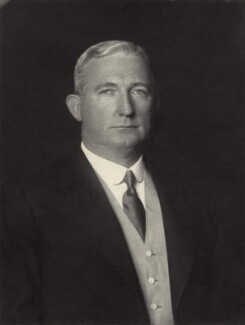Alan Burns (colonial administrator) facts for kids
Quick facts for kids
Sir
Alan Burns
|
|
|---|---|

Portrait by Walter Stoneman, 1934
|
|
| Permanent Representative of the United Kingdom on the UN Trusteeship Council | |
| In office 1947–1956 |
|
| Governor of the Gold Coast | |
| In office 24 October 1941 – 2 August 1947 |
|
| Monarch | George VI |
| Preceded by | Sir Arnold Weinholt Hodson |
| Succeeded by | Sir Gerald Hallen Creasy |
| Assistant Under-Secretary for the Colonial Office | |
| In office 1940–1941 |
|
| Governor of British Honduras | |
| In office 2 November 1934 – 24 February 1939 |
|
| Preceded by | Sir Harold Baxter Kittermaster |
| Succeeded by | John Adams Hunter |
| Deputy Chief Secretary to the Government of Nigeria | |
| In office 1929–1934 |
|
| Colonial Secretary of the Bahamas | |
| In office 1924–1929 |
|
| Personal details | |
| Born |
Alan Cuthbert Maxwell Burns
9 November 1887 Basseterre, Saint Kitts |
| Died | 29 September 1980 (aged 92) Westminster, London, England |
| Nationality | British |
| Spouse |
Kathleen Fitzpatrick Hardtman
(m. 1914; died 1970) |
| Children | 2 |
Sir Alan Cuthbert Maxwell Burns (9 November 1887 – 29 September 1980) was an important British government official. He worked in many different parts of the world, becoming a governor in several colonies. A governor is like a leader or manager of a territory. Sir Alan also wrote books about history and politics. One of his books spoke out against racism, which he called "colour prejudice."
Contents
Early Life and Family Background
Alan Burns was born in Basseterre, Saint Kitts and Nevis, an island in the Caribbean. He had seven brothers and sisters. His father, James Patrick Burns, was a treasurer for the government there. Sadly, his father passed away in 1896 when Alan was young.
In 1901, Alan started studying at St Edmund's College, Ware. This means he officially joined the school. However, he had to leave early because his family could not afford the school fees. His mother passed away in 1914. In the same year, he married Kathleen Fitzpatrick Hardtman. They had two daughters, Barbara and Benedicta.
Sir Alan Burns's Career in Government
Sir Alan Burns held many important jobs in the British government's Colonial Service. This service managed the British colonies around the world.
Early Roles and Military Service
From 1905 to 1912, he worked in the Leeward Islands. After that, he became a Supervisor of Customs in Nigeria. In 1914, he joined the Royal West African Frontier Force, a military group. He fought in the Cameroons Campaign during World War I. He also worked as a Private Secretary for important governors of Nigeria, like Sir Frederick Lugard.
Becoming a Governor
In 1924, Burns was made the Colonial Secretary of the Bahamas. This was a high-ranking job, and he sometimes acted as Governor. He stayed there until 1929. From 1929 to 1934, he was the Deputy Chief Secretary in Nigeria.
Then, at 47 years old, he became the Governor of British Honduras (now called Belize). He served in this role from 1934 to 1939. In 1940, he worked for the Colonial Office in London, helping with special duties.
Governor of the Gold Coast
In 1941, Sir Alan was appointed Governor of the Gold Coast (now Ghana). In 1942, he also served for five months as the acting Governor of Nigeria.
When he returned to the Gold Coast, he made an important change. In 1942, he convinced the Colonial Office to allow Africans to join the Executive Council. This council helped the governor make decisions. In 1946, he helped create a new constitution. This new plan meant that the Legislative Council, which made laws, would have more African members than European members. This was a big step towards self-governance for the Gold Coast.
Later Career and Retirement
Sir Alan Burns resigned as Governor of the Gold Coast in 1947. From 1947 until he retired in 1956, he worked as the UK's representative on the United Nations Trusteeship Council. This council helped countries that were not yet fully independent.
Even after retiring, he continued to be active. In 1959, at age 72, he led a study about the natural resources and population of Fiji. In 1966, he used his connections to help his niece, Dr Marca Burns, safely leave Ghana during a time of political unrest.
Sir Alan Burns passed away in London in 1980.
Honours and Awards
Sir Alan Burns received several important honours for his service:
- Companion of the Order of St Michael and St George in 1927.
- Knight Commander of the Order of St Michael and St George in 1936. This meant he could use "Sir" before his name.
- Knight of the Order of St John of Jerusalem, of Rhodes and of Malta in 1942.
- Knight Grand Cross of the Order of St Michael and St George in 1946. This is a very high honour.

